|
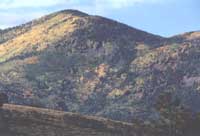 I
am surrounded by history. As golden leaves from the aspens
pirouette and plie in their grand finale, I see the present
but feel the past. Not the ancient past of inland seas recorded
in the fractured rocks that seem carelessly strewn over the
flanks of the mountains, but rather the more recent past,
say the last two thousand years. I
am surrounded by history. As golden leaves from the aspens
pirouette and plie in their grand finale, I see the present
but feel the past. Not the ancient past of inland seas recorded
in the fractured rocks that seem carelessly strewn over the
flanks of the mountains, but rather the more recent past,
say the last two thousand years.
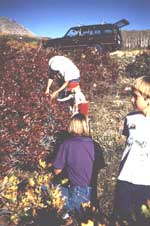 Before
me raises Mount Mellenthin, a balding peak that rises abruptly
from Geyser Pass. Named after Rudolph Mellenthin, a U.S. Forest
Service ranger killed in the line of duty back in 1918. The
official story states that he lost his life while apprehending
a WWI draft dodger. But another version exists that “the
Kaiser,” as this German immigrant was referred to by
the local cowboys, was dealt his fate due to his Teutonic
nature.To the right of Mellenthin, is Mount Peale, a long
ridge that rises up to the highest point in the La Sals at
12,721 feet. Dr. Albert Peale was a mineralogist on the 1875
Hayden Survey, an inland survey that mapped and explored the
La Sal Mountains and other areas in southern Utah. And a bit
farther east is the volcanic looking Mount Tukuhnikivatz -
Tuk for short. There seems to be some confusion from this
name’s origin. Perhaps he was a Ute shaman that members
of the Hayden Survey encountered. Before
me raises Mount Mellenthin, a balding peak that rises abruptly
from Geyser Pass. Named after Rudolph Mellenthin, a U.S. Forest
Service ranger killed in the line of duty back in 1918. The
official story states that he lost his life while apprehending
a WWI draft dodger. But another version exists that “the
Kaiser,” as this German immigrant was referred to by
the local cowboys, was dealt his fate due to his Teutonic
nature.To the right of Mellenthin, is Mount Peale, a long
ridge that rises up to the highest point in the La Sals at
12,721 feet. Dr. Albert Peale was a mineralogist on the 1875
Hayden Survey, an inland survey that mapped and explored the
La Sal Mountains and other areas in southern Utah. And a bit
farther east is the volcanic looking Mount Tukuhnikivatz -
Tuk for short. There seems to be some confusion from this
name’s origin. Perhaps he was a Ute shaman that members
of the Hayden Survey encountered.
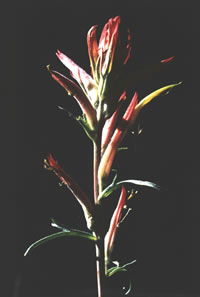 But
it is not only the peaks that remind me of the past. There
is the Indian paintbrush, its crimson flowers boldly in bloom,
advertising to the last hummingbirds and butterflies that
there is still nectar to be had. The bar is still open. The
paintbrush’s genus is Castilleja, after Juan Castilljo
(1744-1793), a Spanish botanist. Below me, withered from early
summer frosts and bearing few browned leaves, is the Gambel’s
oak. William Gambel was a protege of Thomas Nuttall, a famous
naturalist who roamed the west in search of plants and birds.
The Nuttall’s woodpecker bears his name, a. species that
doesn’t reside in these local mountains. But
it is not only the peaks that remind me of the past. There
is the Indian paintbrush, its crimson flowers boldly in bloom,
advertising to the last hummingbirds and butterflies that
there is still nectar to be had. The bar is still open. The
paintbrush’s genus is Castilleja, after Juan Castilljo
(1744-1793), a Spanish botanist. Below me, withered from early
summer frosts and bearing few browned leaves, is the Gambel’s
oak. William Gambel was a protege of Thomas Nuttall, a famous
naturalist who roamed the west in search of plants and birds.
The Nuttall’s woodpecker bears his name, a. species that
doesn’t reside in these local mountains.
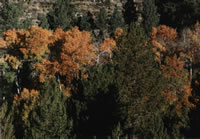
|
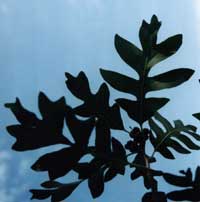 But
this story is about Gambel, who once crossed the Moab Valley
and who later died of typhoid fever at the ripe old age of
30. Even the white-crowned sparrows, mountain residents that
abound in the Moab Valley during the winter, bear his name
Zonotrichia gambelii. But
this story is about Gambel, who once crossed the Moab Valley
and who later died of typhoid fever at the ripe old age of
30. Even the white-crowned sparrows, mountain residents that
abound in the Moab Valley during the winter, bear his name
Zonotrichia gambelii.
Covering the upper flanks of the mountains
are intermixed patches of aspen and spruce. The aspen, Populus
tremuloides, bears golden leaves, indicators of the approaching
autumn. Their 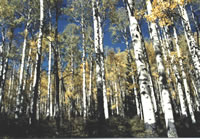 leaves,
borne on long petioles like flag staffs, dance or tremble
in the wind; hence, the species name tremuloides. Where the
aspens stop, the dark zones of Engelmann spruce start up.
Dr. George Engelmann (1805-1884) was a German botanist who
came to America to explore the Mississippi Valley and who
authored many scientific papers. leaves,
borne on long petioles like flag staffs, dance or tremble
in the wind; hence, the species name tremuloides. Where the
aspens stop, the dark zones of Engelmann spruce start up.
Dr. George Engelmann (1805-1884) was a German botanist who
came to America to explore the Mississippi Valley and who
authored many scientific papers.
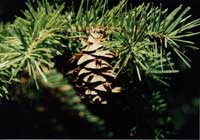 Lower
down on the slopes, and growing near my vantage point, is
another conifer - Douglas fir. Its reddish brown bark is furrowed
into deep grooves which resemble a miniature version of the
Basin and Range Province. The pendulous cones of the Douglas
fir entice mountain chickadees and pine siskins to explore
their scales for seeds and insects. Called Pseudotsuga menziesii,
this tree honors Archibald Menzies (1754-1842) a surgeon and
naturalist who accompanied Vancouver on his Pacific Coast
expedition. Pseudotsuga means “false hemlock,” a
Japanese name bestowed upon this fine tree. Lower
down on the slopes, and growing near my vantage point, is
another conifer - Douglas fir. Its reddish brown bark is furrowed
into deep grooves which resemble a miniature version of the
Basin and Range Province. The pendulous cones of the Douglas
fir entice mountain chickadees and pine siskins to explore
their scales for seeds and insects. Called Pseudotsuga menziesii,
this tree honors Archibald Menzies (1754-1842) a surgeon and
naturalist who accompanied Vancouver on his Pacific Coast
expedition. Pseudotsuga means “false hemlock,” a
Japanese name bestowed upon this fine tree.
The list goes on. Stellar’s jays named
for George W. Steller, a German zoologist and arctic traveler.
Cooper’s hawks that honor William Cooper (1’798-1864),
founder of the NY Lyceum Society. Clark’s nutcrackers,
after Capt. William Clark (17701838) of the Lewis and Clark-Expedition-
I feel a kindred connection, on my autumnal stroll, with the
souls of these great naturalists, surgeons, explorers and
others whose time has passed, but whose epitaphs are not only
etched in stone but are remembered in the flights of birds
or the greenery of vegetation.
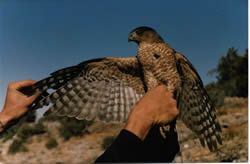
|
 NATURE
HAPPENINGS
NATURE
HAPPENINGS
 Before
me raises Mount Mellenthin, a balding peak that rises abruptly
from Geyser Pass. Named after Rudolph Mellenthin, a U.S. Forest
Service ranger killed in the line of duty back in 1918. The
official story states that he lost his life while apprehending
a WWI draft dodger. But another version exists that “the
Kaiser,” as this German immigrant was referred to by
the local cowboys, was dealt his fate due to his Teutonic
nature.To the right of Mellenthin, is Mount Peale, a long
ridge that rises up to the highest point in the La Sals at
12,721 feet. Dr. Albert Peale was a mineralogist on the 1875
Hayden Survey, an inland survey that mapped and explored the
La Sal Mountains and other areas in southern Utah. And a bit
farther east is the volcanic looking Mount Tukuhnikivatz -
Tuk for short. There seems to be some confusion from this
name’s origin. Perhaps he was a Ute shaman that members
of the Hayden Survey encountered.
Before
me raises Mount Mellenthin, a balding peak that rises abruptly
from Geyser Pass. Named after Rudolph Mellenthin, a U.S. Forest
Service ranger killed in the line of duty back in 1918. The
official story states that he lost his life while apprehending
a WWI draft dodger. But another version exists that “the
Kaiser,” as this German immigrant was referred to by
the local cowboys, was dealt his fate due to his Teutonic
nature.To the right of Mellenthin, is Mount Peale, a long
ridge that rises up to the highest point in the La Sals at
12,721 feet. Dr. Albert Peale was a mineralogist on the 1875
Hayden Survey, an inland survey that mapped and explored the
La Sal Mountains and other areas in southern Utah. And a bit
farther east is the volcanic looking Mount Tukuhnikivatz -
Tuk for short. There seems to be some confusion from this
name’s origin. Perhaps he was a Ute shaman that members
of the Hayden Survey encountered. But
it is not only the peaks that remind me of the past. There
is the Indian paintbrush, its crimson flowers boldly in bloom,
advertising to the last hummingbirds and butterflies that
there is still nectar to be had. The bar is still open. The
paintbrush’s genus is Castilleja, after Juan Castilljo
(1744-1793), a Spanish botanist. Below me, withered from early
summer frosts and bearing few browned leaves, is the Gambel’s
oak. William Gambel was a protege of Thomas Nuttall, a famous
naturalist who roamed the west in search of plants and birds.
The Nuttall’s woodpecker bears his name, a. species that
doesn’t reside in these local mountains.
But
it is not only the peaks that remind me of the past. There
is the Indian paintbrush, its crimson flowers boldly in bloom,
advertising to the last hummingbirds and butterflies that
there is still nectar to be had. The bar is still open. The
paintbrush’s genus is Castilleja, after Juan Castilljo
(1744-1793), a Spanish botanist. Below me, withered from early
summer frosts and bearing few browned leaves, is the Gambel’s
oak. William Gambel was a protege of Thomas Nuttall, a famous
naturalist who roamed the west in search of plants and birds.
The Nuttall’s woodpecker bears his name, a. species that
doesn’t reside in these local mountains. 
 But
this story is about Gambel, who once crossed the Moab Valley
and who later died of typhoid fever at the ripe old age of
30. Even the white-crowned sparrows, mountain residents that
abound in the Moab Valley during the winter, bear his name
Zonotrichia gambelii.
But
this story is about Gambel, who once crossed the Moab Valley
and who later died of typhoid fever at the ripe old age of
30. Even the white-crowned sparrows, mountain residents that
abound in the Moab Valley during the winter, bear his name
Zonotrichia gambelii. leaves,
borne on long petioles like flag staffs, dance or tremble
in the wind; hence, the species name tremuloides. Where the
aspens stop, the dark zones of Engelmann spruce start up.
Dr. George Engelmann (1805-1884) was a German botanist who
came to America to explore the Mississippi Valley and who
authored many scientific papers.
leaves,
borne on long petioles like flag staffs, dance or tremble
in the wind; hence, the species name tremuloides. Where the
aspens stop, the dark zones of Engelmann spruce start up.
Dr. George Engelmann (1805-1884) was a German botanist who
came to America to explore the Mississippi Valley and who
authored many scientific papers. Lower
down on the slopes, and growing near my vantage point, is
another conifer - Douglas fir. Its reddish brown bark is furrowed
into deep grooves which resemble a miniature version of the
Basin and Range Province. The pendulous cones of the Douglas
fir entice mountain chickadees and pine siskins to explore
their scales for seeds and insects. Called Pseudotsuga menziesii,
this tree honors Archibald Menzies (1754-1842) a surgeon and
naturalist who accompanied Vancouver on his Pacific Coast
expedition. Pseudotsuga means “false hemlock,” a
Japanese name bestowed upon this fine tree.
Lower
down on the slopes, and growing near my vantage point, is
another conifer - Douglas fir. Its reddish brown bark is furrowed
into deep grooves which resemble a miniature version of the
Basin and Range Province. The pendulous cones of the Douglas
fir entice mountain chickadees and pine siskins to explore
their scales for seeds and insects. Called Pseudotsuga menziesii,
this tree honors Archibald Menzies (1754-1842) a surgeon and
naturalist who accompanied Vancouver on his Pacific Coast
expedition. Pseudotsuga means “false hemlock,” a
Japanese name bestowed upon this fine tree.